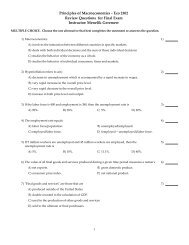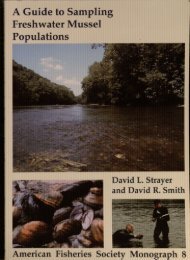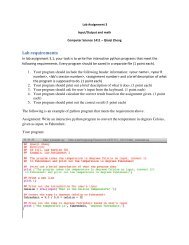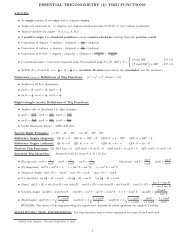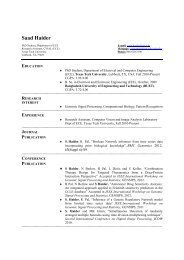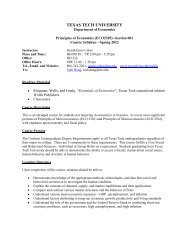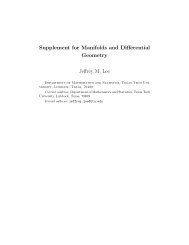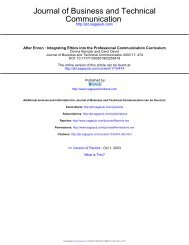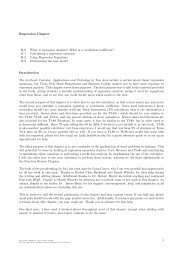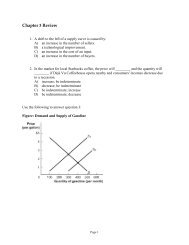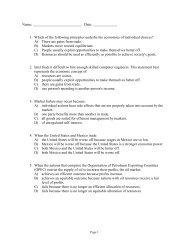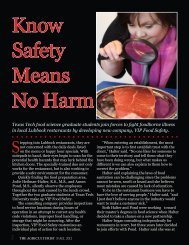Download - MyWeb - Texas Tech University
Download - MyWeb - Texas Tech University
Download - MyWeb - Texas Tech University
You also want an ePaper? Increase the reach of your titles
YUMPU automatically turns print PDFs into web optimized ePapers that Google loves.
Preliminary Comments on the 2012 Ceramics Analysis<br />
early historic period). While Chan Chich lacks<br />
the presence of Chen Mul Modeled, Kaxil<br />
Uinic produced several interesting fragments<br />
of the anthropomorphic censers (see Harris and<br />
Sisneros, this volume, Figure 5.4).<br />
Summary<br />
As concluded by Valdez and Houk (2000:136),<br />
“the ceramic analysis indicates that the ancient<br />
city of Chan Chich was first settled ca. 900 BC<br />
and abandoned by AD 850.” After preliminary<br />
observations of the ceramic artifacts from the<br />
2012 season, the statement remains accurate.<br />
The Chan Chich data are briefly summarized<br />
below and for now include most of the<br />
findings for Kaxil Uinic. The only exception or<br />
significant difference of information concerning<br />
Kaxil Uinic has been presented above.<br />
The Middle Preclassic complexes as part of<br />
the Swasey and Mamom Spheres are certainly<br />
related to other early sites in northern Belize<br />
and northeastern Peten. Although regional<br />
variation is noteworthy. The Late Preclassic<br />
ceramics seem to represent a period that was<br />
of more intensive interaction between sites<br />
and perhaps regions. The Chicanel Sphere is<br />
the designation for this phase at Chan Chich.<br />
In the Late-to-Terminal Preclassic, Chan<br />
Chich was actively involved in the trade (and<br />
communications) systems common throughout<br />
the Maya lowlands. The final Preclassic phase<br />
at Chan Chich is the Terminal Preclassic (Floral<br />
Park Sphere) Trogon Complex.<br />
Following the new developments or<br />
innovations of the Terminal Preclassic, Chan<br />
Chich transitioned into the Early Classic Jabiru<br />
Complex (Tzakol Sphere). While it is clear<br />
that Early Classic occupants were active at<br />
Chan Chich, representative material for the<br />
Early Classic remains scant. No satisfactory<br />
explanation for a weak representation is posited<br />
at this time.<br />
Two ceramic complexes, Motmot Complex and<br />
Pauraque Complex, represent the Chan Chich<br />
Late Classic (Tepeu Sphere). Excavations<br />
continue to produce ceramics of the Late<br />
Classic phase usually with Tepeu 3 material<br />
near or at the surface level. Chan Chich<br />
was a very active member of the Peten and<br />
northern Belize trade and exchange networks<br />
as represented in the ceramic inventories. Chan<br />
Chich’s abandonment at the end of the Classic<br />
period seems clear. There are, however, later<br />
Postclassic visitations with special offerings<br />
(censers), but no permanent Maya occupation<br />
of Chan Chich is known after the Tepeu 3<br />
period.<br />
References Cited<br />
Adams, Richard E. W.<br />
1971 The Ceramics of Altar de Sacrificios. Papers of the Peabody Museum, No. 63. Harvard<br />
<strong>University</strong>, Cambridge, Massachusetts.<br />
Adams, Richard E. W., and Jane Jackson-Adams<br />
2000 Rio Azul Ceramic Sequence Summary; 1999. In Rio Azul Reports Number 5, The 1987<br />
Season, edited by R. E. W. Adams, pp. 264–273. The <strong>University</strong> of <strong>Texas</strong> at San Antonio.<br />
Ball, Joseph<br />
1977 The Archaeological Ceramics of Becan, Campeche. Middle American Research Institute<br />
Publication No. 43. Tulane <strong>University</strong>, New Orleans.<br />
69



